INTRODUCTION
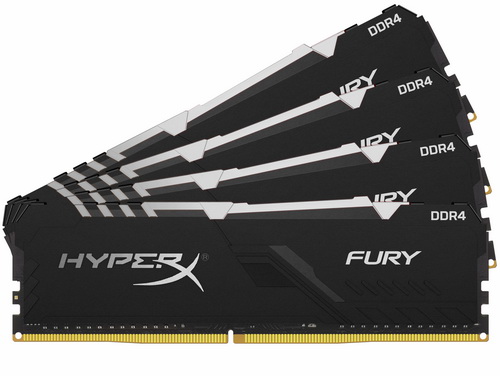
As far back as i can remember mainstream and professional PC usage has always relied on two of the most crucial hardware components, the CPU (central processing unit) and the RAM (random access memory). Leaving out the somewhat complex architecture technologies used the CPU has always been about three things, speed (MHz), number of available cores and available cache (MB) whereas the RAM has always been also about three things, amount (GB), speed (MHz) and latency (CL). Of course, the CPU has always been integral for gamers as well as has the amount of RAM installed in a system but as for speed and latency, well not so much. Today with me i have yet another Quad Channel DDR4 RAM, the Fury RGB 64GB 2666ΜΗΖ CL16 kit by HyperX.
HyperX is the gaming division of Kingston Technology Company, Inc., the world’s largest independent memory manufacturer, with the goal of providing gamers, PC builders, PC, console and mobile power users with high-performance components. For 16 years, the HyperX mission has been to develop gaming products for all types of gamers – high-speed memory, solid state drives, headsets, keyboards, mice, charging accessories for console players, USB flash drives, and mousepads – to the gaming community and beyond. The award-winning HyperX brand in known for consistently delivering products that deliver superior comfort, aesthetics, performance, and reliability. HyperX gear is the choice of celebrity ambassadors, pro gamers, tech enthusiasts, and over-clockers worldwide because it meets the most stringent product specifications and is built with best-in-class components. HyperX has shipped over 60 million memory modules and 7 million gaming headsets worldwide.
The Fury RGB line of DDR4 modules by HyperX is XMP 2.0 certified and is currently available in 8/16GB single, 16/32GB dual and 32/64 quad-channel kits (the HX426C16FB3AK4/64 kit was used in this review) with frequencies all the way up to 3733MHz (2400/2666/3000/3200MHZ/3466/3600/3733MHz), CAS latency timings set as low as 15 (2400/2666/3000MHz CL15 - 2666/3200/3466MHz CL16 - 3600MHz CL17 - 3733MHz CL19) and voltages up to 1.35v (2400/2666MHz 1.2v - 3000/3200/3466/3600/3733MHz). Inside the low-profile black heatspreaders HyperX has placed single rank 8GB J-Die memory chips by Micron (at least in our kit, other higher frequency kits are reported to have memory chips by SKhynix and others), their very own patent-pending infrared sync technology (ensures that the selected RGB effect is in sync with every module of the kit - still with a maximum range of almost 2cm between each module it may not be 100% effective with some quad-channel mainboards) and a RGB LED bar with a total of 8 effects and full compatibility with all the popular mainboard sync technologies (including ASUS AURA Sync, GIGABYTE RGB Fusion, MSI Mystic Light Sync and ASRock RGB Sync). Naturally HyperX covers the entire Fury RGB line of DDR4 RAM with a limited lifetime warranty.
SPECIFICATIONS AND FEATURES

ΤΗΕ FURY RGB 64GB DDR4 2666MHZ CL15 KIT
The four 16GB modules arrived inside 2 blister packages attached together.
Along with the 4 memory modules HyperX also bundles a case sticker and an warranty and quick installation guide.
HyperX has used black polished aluminum heatspreaders with their Fury RGB line which have their logo and product line name on one side and a small sticker containing the serial number, frequency, timings and voltage requirement on the other.
The RGB LED bar covers the entire top of each of the modules so it should look nice.
Ι placed the Fury RGB right next to the Crucial Ballistix Elite to showcase the low-profile heatspreaders (41.24mm top to bottom).
Here you can see how the Fury RGB modules look when attached onto our X299 test rig (you may not see the top modules but they did sync with the bottom ones without issue).
Here you can see what the popular Thaiphoon burner software reports about our Fury RGB DDR4 kit.
NGENUITY SOFTWARE
Once you install (via Microsoft Store) and launch the software all detected device will be placed on the left side (just the memory kit in our case).
Clicking on the memory will open the configuration screen from where you will see the currently loaded RGB lighting effect and color.
From the top left corner, you can access one of the three available presets (you can link them to specific games) and adjust the brightness levels of the RGB LED light bar.
As mentioned earlier you can choose between a total of 8 available RGB lighting effects and adjust their speed (if you choose the static color effect you can also choose the desired color).
Inside the settings tab you can change the language of the software, enable/disable the Gamelink option, have the software start up with Windows, check the current software version and its release notes, see the exact product model compatible with NGENUITY and get support from HyperX.
Again, the Fury RGB modules are fully compatible with all the popular mainboard RGB sync technologies so it's no wonder that our GIGABYTE Aorus Gaming 9 detects them just fine.
TEST BED
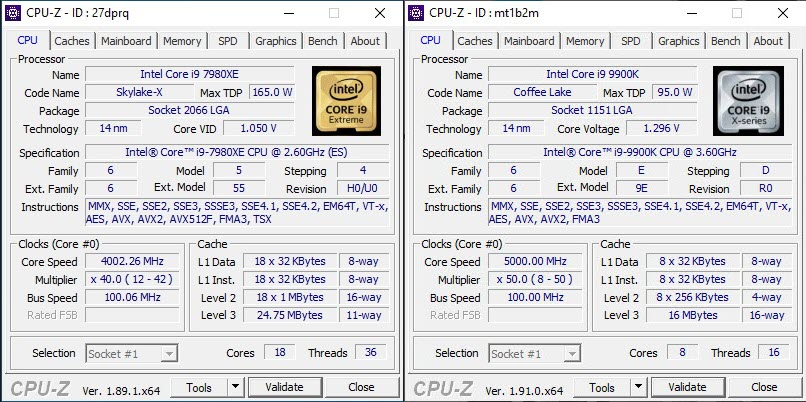

TESTING METHODOLOGY

Thanks to XMP (2.0) profiles the only thing one needs to do in order to run this RAM kit at its advertised frequency, timings and voltages is to choose/enable it from within the Bios and reboot. That being said if you're into overclocking you may not wish to use the main XMP profile but instead to choose your very own frequency, timings and voltages to achieve even higher performance numbers and that's exactly what we'll also be doing during our DDR4 tests. To be more specific aside testing each kit with its XMP profile we will also be upping the voltages (up to 1.4V max – even though most kits can function at higher voltages I don’t recommend doing so) and frequencies (200MHZ increments) until we find the maximum achievable stable frequency. We also thought about upping voltages and reducing timings instead of increasing the frequency of the modules as high as it can go (always stable and without going over 1.4V) but the end results are pretty much identical.
As for the how we'll be testing each DDR4 Quad-Kit to arrive in our lab well there aren't that many benchmark programs that only test RAM (or at least RAM and CPU without anything else coming into play) but we got most of them and so you will be seeing results from following benchmarking programs, AIDA64 Engineer Edition, Cinebench Release 20, MaxMemm2 (because we are getting low performance numbers this doesn't seem to play well with our test rig - probably because of the X299 architecture - but we decided to include it regardless), Passmark Performance Test 9, Sisoftware Sandra Titanium and WPrime v1.55. All tests are performed on a fresh Windows 10 Pro installation (complete with all updates until the day of this review) and are repeated a total of 6 times after which the average numbers get recorded into our charts.
* In addition to Quad-Channel tests since March 2020 I’ll also be using the brand new Z390 test rig (check above) for Dual-Channel RAM tests.
** Since May 2020 three game benchmarks (Assassin’s Creed Odyssey, GEARS 5 and Metro Exodus tested on the X299 system at 1080p resolution and with the ASUS ROG RTX2060 OC set at Gaming Mode) have also been added in the charts.
TEST RESULTS – XMP PROFILE / QUAD CHANNEL
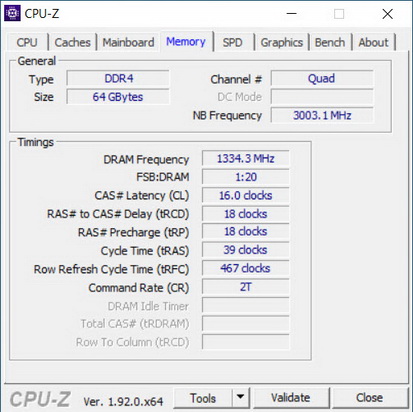







TEST RESULTS – XMP PROFILE / DUAL CHANNEL







TEST RESULTS – OVERCLOCK / QUAD CHANNEL


Unfortunately even though for some unknown reason I was unable to push this kit (two modules) above its rated speed with the Z390 test rig I was able to climb up to a stable 3200MHz CL18 by upping the voltage to 1.36V (I was able to hit 3400MHz CL18 at 1.4V but it wasn’t stable during the game benchmarks).
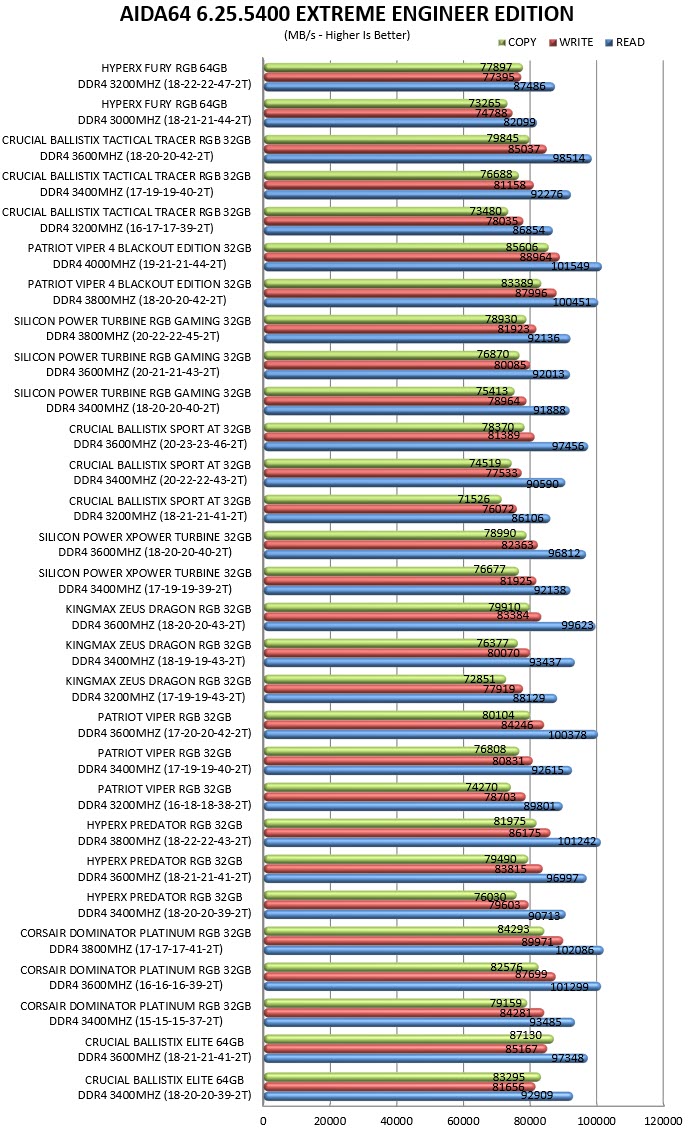






CONCLUSION

When HyperX informed me that they were sending the 2nd slowest model in the Fury RGB line I admit I was somewhat worried about its performance. That of course was until I saw that its rated speed was for 2666MHz at 1.2V (AMD Ryzen compatible) so naturally when I started overclocking the kit I went directly to 3000MHz at 1.3V (I did try 3000MHz at 1.25V and 1.28V without luck, at least not at CL18) and as you can see from the charts next in line was 3200MHz at 1.36V (I was able to hit 3200MHz at 1.35V but it wasn’t stable during the game benchmarks, again not at CL18). However, it’s clear from our game benchmarks that even by increasing the MHz of the RAM by over 430MHz the maximum fps gains were less than 4% (and the same pretty much goes for every other kit here). Extreme RAM overclocking may yield better results but I doubt that’s really worth the amount of effort required (overclocking your graphics card seems like the easiest choice to gain a few fps more). As for looks well the Fury RGB may not stand out like the Trident Z Royal by GSkill (not many modules do currently) but that always comes down to taste.
Currently the Fury RGB 64GB DDR4 2666MHz CL15 quad-channel kit by HyperX retails for USD301.99 inside the USA (Amazon.com) and for around 340Euros inside the EU, a price which is quite justified for a quad-channel 64GB kit (still the 3200MHz kit however is worth just USD14 more in the states so I suggest going for that instead). Long story short even though at default the HyperX HX426C16FB3AK4/64 kit may not impress with its performance it can easily go up to 3200MHz (even 3400/3600MHz depending on your motherboard) and that along with its very good RGB lighting system, AMD Ryzen compatibility (1.2V) and the limited lifetime warranty certainly make it worth our Golden Award.

PROS
- Build Quality
- Top RGB LED Bar (AURA Sync, GIGABYTE RGB Fusion, MSI Mystic Light Sync & ASRock RGB Sync Compatible)
- NGENUITY Software (8 Available Lighting Effects)
- Overall Performance (2666MHZ CL15 / Up To 3200MHz CL18)
- Short Heat Spreaders (Reduced Possibility of Clearance Issues)
- AMD Ryzen Compatible (1.2V)
- Limited Lifetime Warranty
CONS
- Kits with Capacities Only Up To 64GB
- NGENUITY Software (Windows 10 Only)

 O-Sense
O-Sense





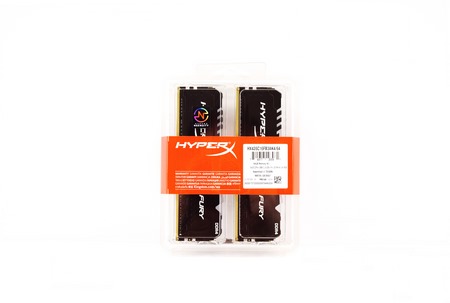









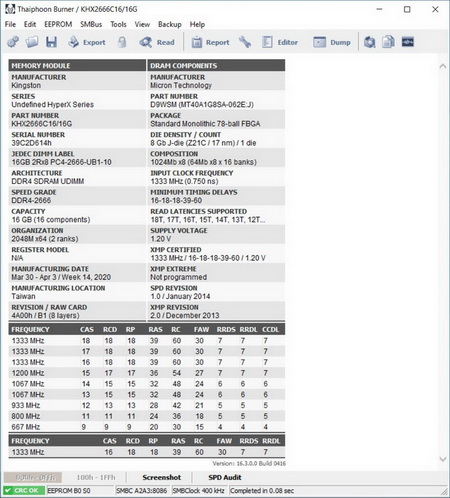
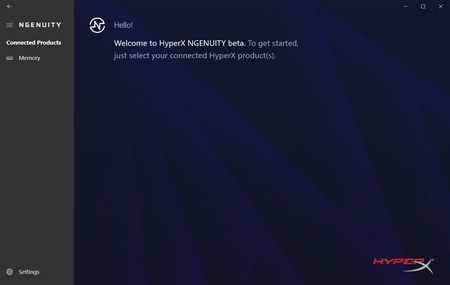









.png)

